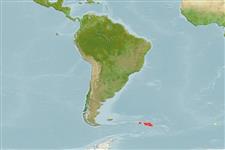Preferred temperature (Ref.
123201): -0.1 - 1.5, mean 0.6 °C (based on 10 cells).
Phylogenetic diversity index (Ref.
82804): PD
50 = 0.7500 [Uniqueness, from 0.5 = low to 2.0 = high].
Bayesian length-weight: a=0.00224 (0.00117 - 0.00427), b=3.25 (3.07 - 3.43), in cm total length, based on LWR estimates for this (Sub)family-body shape (Ref.
93245).
Trophic level (Ref.
69278): 4.0 ±0.6 se; based on diet studies.
Resilience (Ref.
120179): Medium, minimum population doubling time 1.4 - 4.4 years (Fec = 8,585).
Fishing Vulnerability (Ref.
59153): Moderate to high vulnerability (49 of 100).
Climate Vulnerability (Ref.
125649): Very high vulnerability (88 of 100).
Nutrients (Ref.
124155): Calcium = 31 [19, 71] mg/100g; Iron = 0.528 [0.229, 1.047] mg/100g; Protein = 17.6 [16.6, 18.5] %; Omega3 = 0.226 [0.118, 0.429] g/100g; Selenium = 20.6 [8.6, 46.2] μg/100g; VitaminA = 10 [2, 46] μg/100g; Zinc = 0.387 [0.258, 0.581] mg/100g (wet weight);
